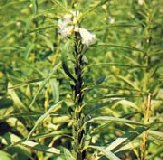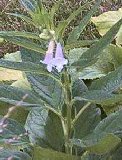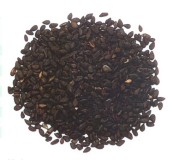Sesame Seed, Black
http://www.100md.com
《e Natural Health Center》
 |
 |
 |
 |
Nuts and Seeds
Sesame Seed, Black
Latin:
Sesamum indicum
Origin:
Sesame is an erect, annual plant Sesamum indicum L., or Sesamum orientale, of numerous types and varieties belonging to the family Pedaliaceae, cultivated since antiquity for its seeds, which are used as food and flavoring and from which a prized oil is extracted. The name goes back to Greek seesamon, which in turn was probably loaned from an Afro-Asiatic language (cf. Arabic saasim). There are two kinds of sesame, black and white.
, 百拇医药
Probably originating in Asia, the Chinese used it 5,000 years ago, and for centuries they have burned the oil to make soot for the finest Chinese ink blocks. Records show it has been cultivated in parts of India around 1600 BC. From there it was brought to Europe, grown in Egypt, and its value both medicinally and for cooking gradually spread throughout Europe. The Romans ground sesame seeds with cumin to make a pasty spread for bread. Once it was thought to have mystical powers, and sesame still retains a magical quality, as shown in the expression "open sesame," from the Arabian Nights tale of "Ali Baba and the Forty Thieves." In Africa the seeds, called benne, were eaten as food as well as being used for oil and the seeds were taken by the slaves to America where it has been a cultivated food crop ever since.
, 百拇医药
The whole seed is used extensively in the cuisines of the Middle East and Asia. Halvah is a confection made of crushed and sweetened sesame seeds. In Europe and North America the seeds are used to flavor and garnish various foods, particularly breads and other baked goods. The aroma and taste of sesame seed are mild and nutlike.
Sesame oil is used as a salad or cooking oil, in shortening and margarine, and in the manufacture of soaps, pharmaceuticals, and lubricants. It is used as an ingredient in cosmetics. The press cake remaining after the oil is expressed is highly nutritious.
, http://www.100md.com
Sesame is now found in most of the tropical, subtropical, and southern temperate areas of the world. Although a major world oilseed crop, sesame is primarily grown by small farmers in developing countries in the southern latitudes.
The plants grow best in tropical climates, from spring to fall. Depending on conditions, varieties grow from about 0.5 to 2.5 m tall. The annual, erect plants, some have branches, others do not. The ovate leaves are opposite, grow alternately up the stem and are deeply veined. The flowers are white and shaped like a trumpet, on short peduncles in axils of leaves. One to three flowers appear in the leaf axils.
, 百拇医药
The fruit, about 2.5 cm long, is an oblong capsule with small seeds. Each plant may grow 15-20 fruits, which contain 70-100 seeds each. Plants and fruits will reach maturity in 80-100 days after sowing. When the seeds are ripe the capsule bursts open suddenly and scatters its seeds. The hulled seeds are creamy or pearly white and about 3 mm long and have a flattened pear shape. In the Orient, the matured whole plants are harvested and set in the field for 5-10 days under sun, resulting the capsule tips to dry and crack, and then remove the seed capsule for collecting seeds inside. The tiny seeds are flat, shiny and egg-shaped and according to the variety, are either greyish-white, red, brown or black.
, 百拇医药
Total world production of sesame in 1986 was 2.4 million metric tons, 65 percent of which was produced in Asia. The U.S. is the largest importer of sesame, importing about 40,000 metric tons per year, mostly from Mexico. Almost all sesame consumed in the U.S. is as a spice for food products such as hamburger buns and other bakery goods. Minor uses of sesame oil include pharmaceutical and skin care products and as a synergist for insecticides.
Sesame grows best in sandy well-drained soil and a hot climate with moderate rainfall. It is propagated by seed sown in Spring and it takes about four months for the seeds to ripen fully. The crop is then cut, tied in bundles and threshed. After threshing the seeds are cleaned and dried and usually hulled.
, http://www.100md.com
Also called Benne Seed.
See also Herbs, Tonics for Deficiency Syndromes, Yin Tonics, Black Sesame Seed.
Properties:
Sweet in flavor, mild in nature, it is related to the liver, kidney and large intestine channels.
Functions:
Nourishes the liver, kidney, and all internal viscera, benefits qi and blood, produces yin (body fluid) and lubricates the intestines, promotes lactation.
, http://www.100md.com
Applications:
Seseme seed benefits the body as a whole, especially the liver, kidney, spleen and stomach. Its high oil content lubricates the intestines and nourishes all the internal viscera. It also blackens one's hair, especially the black sesame. Hence, it is applied to white hair, habitual constipation, and insufficient lactation. Sesame oil is also helpful in treating intestinal worms like ascaris, tapeworm, etc.
, http://www.100md.com
1. For general weakness and infirmity:
Use 30 g black sesame seeds and boil with 100 g sweet rice to make porridge. Add appropriate sugar after well done.
2. For dizziness due to deficient liver and kidney, and premature white hair:
Decoct black sesame seeds, Chinese wolfberry fruit and tuber of multiflower knotweed, each 15 g, and 9 g chrysanthemum in water for 15 minutes under slow fire. Drink the decoction once daily for a long period of 1-2 months.
, http://www.100md.com
3. For constipation due to drying intestines of the blood and yin (body fluid) insufficiency type, vertigo (an illusion of movement, a sensation as if the external world were revolving around the patient--objective vertigo--or as if he himself were revolving in space--subjective vertigo) and dizziness due to deficient liver and kidney:
a) Crush some walnut, and pulverize dry mulberry together with equal amount of black sesame seeds. Mix all ingredients with bee honey. Administer 2-3 teaspoonfuls, 3 times daily.
, 百拇医药
b) Used with Chinese angelica root, desert living cistanche, hemp seed, etc.
4. For chronic rhinitis (inflammation of the mucous membrane of the nose) with running nose:
Heat 20 ml. sesame oil. Drop few drops of cooled boiled oil to each nostril, thrice daily.
5. For toothache:
Boil 50 g sesame seeds in 500 ml water. Use the solution for gargling.
, http://www.100md.com
6. For promoting lactation:
Bake sesame seeds to brown and grind into powder. Eat as one likes.
7. For poor eye-sight and early greying of hair due to insufficiency of liver and kidney blood:
Sesame seed could be used alone, or it could be used with mulberry leaves, prepared Rehmannia root, glossy privet fruit, eclipta, etc.
Dosage and Administration:
, 百拇医药
10-30 g.
Decoction, or made into porridge along with rice, or used as an ingredient of boluses. Or fried and grinded into powder form, and taken with salt. They can also be eaten by chewing the raw seeds.
Sesame seeds can also be decocted for bathing or pounded for external application.
Cautions on Use:
It should be avoided by those who suffer from loose stools due to insufficiency of the spleen.
, 百拇医药
Reference Materials:
Toxic or Side Effects:
Modern Researches:
The chief constituent of the sesame seed is its fatty oil, which usually amounts to about 44 to 60 percent. Noted for its stability, the oil resists oxidative rancidity. The excellent stability is due to the presence of natural antioxidants such as sesamolin, sesamine and sesamol. The fatty acid composition of sesame oil varies considerably among the different cultivars worldwide. It also contains much fat, mainly glyceride loneleic acid, sucrose, lecithin, protein, etc. Also vitamins A, D and E.
, 百拇医药
Sesame oil is mostly composed of triglycerides of the singly unsaturated oleic acid (40 percent) and the doubly unsaturated linoleic acid (45 percent), besides approximately 10 percent saturated fats (iodine index 110). Because of its powerful antioxidant and because triply unsaturated fatty acids are missing, sesame oil has an excellent shelf life.
Oriental sesame oil owes its characteristic flavor to several compounds which form only during the toasting procedure. Most prominent are 2-furylmethanthiol, which also plays an important part in the flavor of coffee and baked meat, guajacol (2-methoxyphenol), phenylethanthiol and furaneol (4-hydroxy-2,5-dimethyl-3 (2H) furanone); furthermore, vinylguacol, 2-pentylpyridine and other N-containing heterocycles are reported.
, http://www.100md.com
After oil extraction, the remaining meal contains 35-50 percent protein, and is rich in tryptophan and methionine. Seeds with hulls are rich in calcium (1.3 percent) and provide a valuable source of minerals. The addition of sesame to the high lysine meal of soybean produces a well balanced animal feed.
Sesame oil is used in the preparation of Iodinol and Brominol, which are employed for external internal or subcutaneous use. The best qualities of the oil are largely used in the manufacture of margarine. Sesame oil may be used as a substitute for olive oil in making the official liniments, ointments and plasters in India and Africa. The leaves which abound in gummy matter when mixed with water form a rich bland mucilage used in infantile cholera, diarrhoea, dysentery, catarrh (inflammation of a mucous membrane, especially such inflammation of the air passages of the head and throat) and bladder troubles, acute cystitis (inflammation of the urinary bladder) and strangury (painful discharge of urine, drop by drop). The oil is said to be laxative and to promote menstruation., 百拇医药